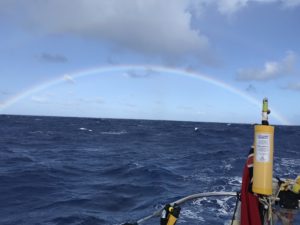December 4th
We are consistently sailing on a heading between 245 and 290 degrees. Rhum line to St Lucia is 245 but the wind does not always allow us to point in that direction. The wind is blowing from NE to SE. We pick our sail configuration based on the wind direction wind angles and wind speed. We are constantly looking at the instruments and making calculations in our heads in order to have a safe point of sail and maximize the wind we have at any given time. We jibe, we make sail changes all manoeuvres taking on a degree or risk in these swells that is not as present in coastal sailing. We have a huge distance racing sail called a Jib Top and when when the winds are right and we fly that sail we at add least 1.5 knots to our speed. The Jib Top is a reaching sail and so we are often pushing it to use this sail and requires a lot of concentration on the helm.

Running with a poled out job top.
We are now at 20 degrees of latitude so are firmly established in the trade winds. The trade winds or easterlies are the permanent east-to-west prevailing winds that flow in the earth’s equatorial region. Ships have taken advantage of these winds for hundreds of years.
The trade winds act as the steering for tropical storms that form over the Atlantic, Pacific and southern Indian Ocean and make landfall in North America, Southeast Asia and eastern Africa. Trade winds also transport African dust westward across the Atlantic Ocean into Caribbean Sea. In this weather pattern portions of cumulus clouds cover the sky on a daily basis.

Reach with the Jib Top as the sun sets.
In addition to paying attention to what is going on above the water, I become aware that there is a lot going on under the water. I start to notice all of the underwater mountains on the chart as we are about to cross the longest mountain range in the world. It is located along the floor of the Atlantic Ocean and called the Mid Atlantic Ridge.
It creates it own weather conditions down there as under water storms rage through the mountainous terrain below us. Meanwhile above, there are often rainbows after the storms.

Rainbow after the storm